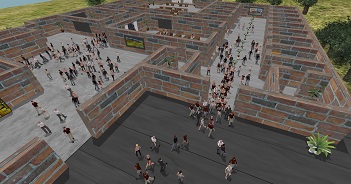Abstract
We present a crowd simulation model that combines the advantages of agent-based and flow-based paradigms while only relying on local information. Our model can handle arbitrary and dynamically changing crowd densities, and it enables agents to gradually interpolate between individual and coordinated behavior. Our model can be used with any existing global path planning and local collision-avoidance method. We show that our model reduces the occurrence of deadlocks and yields visually convincing crowd behavior for high-density scenarios while maintaining individual agent behavior at lower densities.
Reference
-
Arthur van Goethem, Norman S. Jaklin, Atlas F. Cook IV, Roland Geraerts. On Streams and Incentives: A Synthesis of Individual and Collective Crowd Motion. In Computer Animation and Social Agents, 2015.

Movie
The steps of our algorithm are visualized in the movie below.





